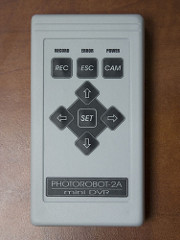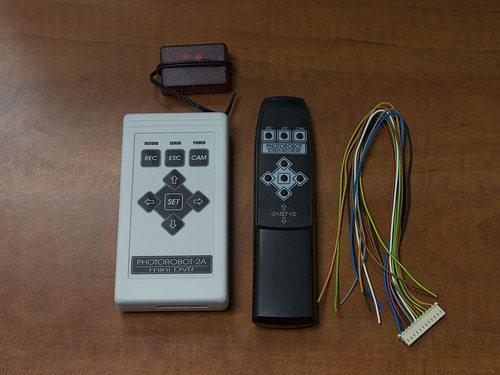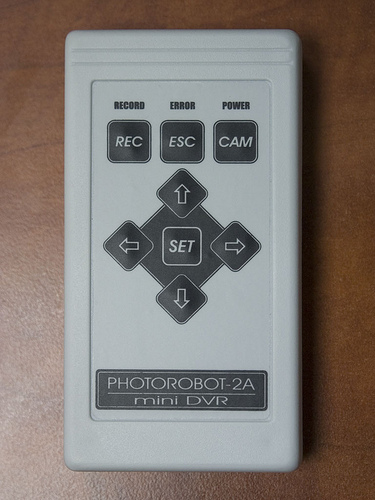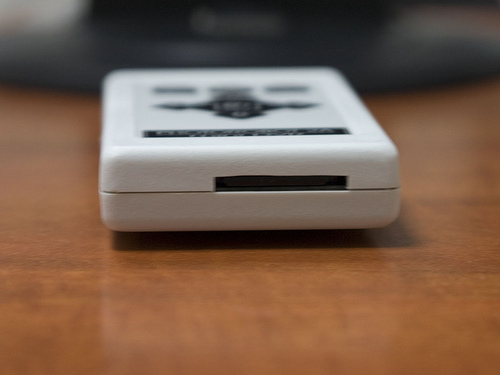PHOTOROBOT-2A Review (traffic)

Today I would like to introduce you to a rather interesting and atypical device.
I got into the hands of a mini DVR (Digital Video Recorder) PICTURE-2A manufactured by SAY Technology - a device for recording audio / video from two cameras on an SD / SDHC memory card. But, unlike the Chinese toy pocket DVRs, designed to record life curiosities, followed by posting on YouTube, this device is designed to quietly and quietly, from year to year, record everything that it sees and hears, until the “H” hour comes or time "B" and we will not need his record. Such a white "black box".
Positioning
The manufacturer positions the device as a compact stand-alone professional digital video surveillance system (digital video recorder, DVR) of the SOHO class. Yes - it is a compact video surveillance system, but with two “but”.
')
The first "but" refers to the words "compact" and "autonomous." In this case, it does not mean "portable" or "mobile."
In this case, “compactness” and “autonomy” means:
- small dimensions
- modest power consumption
- wide installation possibilities
- work without a computer
The second "but" refers to the word "video surveillance". Looking ahead to say that you should not expect from the device pictures DVD quality. In most cases, for large professional video surveillance systems, they are limited to very modest fps and mostly stop at values from 2 to 12 frames per second - these values are enough to clarify the essence of what is happening. There is a trade-off between the “vividness” of the picture and the recording duration - the higher the fps, the less time you can store the recording on the same medium. PHOTOROBOT is no exception - the recording speed in this model is limited to 4 frames per second, which, in principle, should be enough for the SOHO sector.
The main areas of application are the protection of small mobile and stationary objects. It is possible to install the PHOTO ROBOT in the car to record what is happening around and protect yourself from false accidents, as well as at home, by viewing and recording the nearby territory. It is possible and hidden to install inside the office / apartment to monitor negligent employees or a new maid (we will leave the legal side of the issue behind the scenes, now this is not about that).
Equipment
The device is mainly supplied in an enclosure for placement indoors and with a complete set of everything necessary for installation, but there are options and OEM configurations, for example ViP, ViP-S for installation in household intercoms - these are slightly modified PHOTO BOARD boards with additional functions, or Available in an industrial protected enclosure with built-in UPS.
To me on the test device came in a typical version. It can record data from two analog cameras with sound to an SD / SDHC format card up to 32Gb, which is more than enough for many tasks. The output of the “picture” is realized through a low-frequency Video / Audio output. Thanks to the video output, we can view the picture from both cameras (in turn) in real time, view the menu and configure the device itself, but more on that below.
Print the box and examine the contents. The package includes the device itself in a compact plastic case with a bracket for mounting on the wall, an interface cable, a remote control, two AA batteries for the remote control, a remote IR signal receiver and an instruction manual.

My equipment differs from the reference one in the presence of a power supply, a SD 1Gb memory card, an already soldered loop on which audio / video output, a camera, a microphone, an IR receiver and a power supply connector are mounted - thanks to the guys for saving my time to search for a soldering iron :)
The case of the device is made of plastic, assembled firmly (does not creak). On the front panel you can see the navigation buttons and labels for LEDs. Buttons and LEDs are sealed with a plastic washable membrane. In addition to the buttons and labels to the LEDs - below the name of the model of the device. Everything is quite neat and concise: everything is and nothing more.

On the back there is a steel bracket for mounting on the wall, a connector for the interface cable and a small service connector. Service cable and software are available on the manufacturer's website for partners and service centers.

Below the device is a slot for a memory card, so that to remove it, there is no need to remove it from the wall. Given the relatively low power consumption, and, accordingly, heat dissipation - the device can be “sewn up” into furniture, a wall, a false ceiling, or any other secluded place, as many do, thus complicating the task for thieves.

On the remote I would like to stay in more detail. It is compact, lightweight, completely ergonomic. But most importantly - the location of the control elements exactly duplicates those on the case of the device itself -

All I / O signals are concentrated on one “comb” (on the back wall of the device) to which the bundled cable is connected. The wiring of the cable is provided in the instructions; there is nothing complicated in it, so there should be no connection problems. It is clear that the installation of the device is not on the shoulder of the average housewife, but if you don’t get a soldering iron out of your hands, you can handle it. Such a solution, unlike a pile of cables, also seems more reasonable to me (makovods will understand me :)).

Enable and configure
We unpack, connect and watch - it looks like something is happening. The record LED flashes, so the device is ready to work out of the box and immediately starts to work at the first start.
Apparently the map, which I was provided with, was already formatted. And what will happen if you pull out the package and insert another (put yourself in the place of an ordinary consumer)? But about such a dialogue is built if you insert a 32Gb SDHC card and agree to everything.

When connected to a TV, we see a live picture from the camera (if two are connected, you can switch between them) and we can go to the menu. Do not rush to check the quality of the wire and climb into the settings of the video output standard, the interface and the truth are b / w - the vision does not deceive you. At first, it's strange, and then you get used to it - the b / w interface does not distract from images from b / w cameras. The manufacturer deliberately limited the capabilities of the device, and it works only with b / w video signal, since Most of the professional surveillance cameras in all price categories are black and white, and it is not often necessary to use color cameras, especially since black and white cameras both have more detail and sensitivity than color cameras of the same class, and the price is much lower. We are currently considering a lower price range recorder and there is not much point in threatening the use of expensive cameras. From experience, I would say that a color camera that is capable of producing a more or less acceptable image in low light (corridors, landings, backyards) will cost much more than such a recording device, and in this aspect I personally agree with the manufacturer that color support not really needed.
The menu is graphical, fairly informative and consists of four points:
- View Records
- System Setup
- Login Setup 1
- Input 2 Setup
First impression: the menu does not slow down! :)
Second: the shapes of the corners are rounded - hello CSS :)
When viewing, we can choose a camera, use the calendar navigation, where the dates for which there are records are marked. Everything is intuitive and does not require reading the documentation. For this special thanks to the developers. Such a simple and convenient navigation through the archive can not always be found even in large professional systems, of which I have seen a lot, and even more so in the compact.

In the system settings, you can set the date / time (the day of the week is considered automatically), select the recording resolution, format the video signal for output to a TV or monitor, format the memory card, adjust the response to alarm sensors, update the firmware and view information about the current

In the settings of the cameras (channels), you can select the frame rate for each recording mode, after-recording time, motion detection parameters (object size, mask), microphone trigger level, external sensor recording, timer recording.

The number of options struck me personally. The capabilities of the device are not limited to just recording the movement, as shown by a more detailed study, on its basis you can build a fairly serious event recorder for a small object.
The reader may be confused by a low recording resolution (maximum 420x256), but for surveillance cameras of the initial and intermediate levels this is a typical resolution (cameras at 420tvl), more can be achieved only by interpolation or on cameras whose price is much higher than the tested recording device.
It is also worth noting that the data is written to the memory card without compression, so you will not find any JPEG artifacts, as well as the compression level settings. So even at low resolution, the picture quality is subjectively higher than what some soap boxes do at higher resolutions (I’m not talking about 8Mpx of course, but about comparable ones). For example, my old Nokia 9500 (640x480) with good lighting removes a little worse detail, and with a weak one, even wild noises climb out. Noises - understandably, the problem of the old matrix, but the details - just the problem of JPEG compression, which seems to be “not noticeable”, but it steals details.
In terms of the quality of the recording, I can say that it is expected - everything that cameras of the class 420tvl PHOTOROBOT-2F give out will be recorded and reproduced without loss, which is exactly what it was designed for.
Recording can be configured as a constant, and the movement and / or signal from external sensors. Sensors are supported with a standard connection, the same as that used for the usual "security". You can connect them to all the same common bus. There are two independent inputs to which you can hang by a group of sensors, thus controlling two independent zones, each of which will contain a camera, a microphone and a set of sensors.
Soft
If there is a need to review the archive in detail, save / print some parts, all this can be done with the help of a computer and more viewing options and a more familiar mouse interface :). To do this, remove the memory card (there is no need to turn off the device, after all, HotSwap :) and insert it into the card reader. Only Windows family operating systems are supported. The card is formatted in its proprietary format - only original software can work with it. And so, if you have Windows and the autoload is not disabled, then the native utility for working with the card will start immediately, if you know where to disable autoloading, you will probably guess how to start the installer from the open section of the memory card. This is the most open section with proprietary software that appears when a card is formatted in the device (one more plus to the manufacturer’s karma is no disks with software). The program is launched and installed in the system in the background and automatically entered into the autoload - it may not be the most correct behavior, from the point of view of the advanced user, but for the beginner it is. After launching, it settles in the tray and automatically pops up when it recognizes the PHOTO format in the inserted card.
I will not begin to describe the software for a long time - if you wish, you can download the sample from the manufacturer’s website and test it yourself, like the sample record. I will list the main functions:
- View records synchronously from two cameras in one window
- View timeline with filtering by event type
- Brightness / contrast settings of the picture and audio volume in real time for each camera (channel) separately
- Export individual frames to BMP files
- Export video to AVI files
- Saving to the hard disk of the computer or any other media archive records in the original format
- Work with the calendar to search, as well as on the device itself

But this opportunity is particularly pleasing:

those. I can host a full archive of records in my native format on my screw for further viewing through the supplied software.
The software was particularly pleased with the fact that the Chinese counterparts view records by a primitive player a la Windows Media Player, where rewind, fast forward, reverse look, frame by frame, real-time stamp, synchronization with sound and other chips are missing as a class.
findings
I can say that I happened to touch a very nontrivial piece of hardware called PHOTOROBOT-2A. Externally, the device looks much simpler than it turns out later. I absolutely did not expect so many options to fine-tune the operation of the device. In general, I will try to reduce all impressions to two standard summary lists.
Pros:
- compactness
- energy efficiency
- autonomy
- two inputs (usually compact DVRs come with one input or even a built-in camera that immediately kills the possibility of hidden or outdoor installation)
- the ability to connect external sensors
- a huge number of options for fine-tuning the motion, sound and sensor detectors
- SDHC card support
- data storage without compression (respectively, without loss in quality)
- convenient menu
- convenient multi-functional, but fairly simple software that is constantly updated, being finalized and available both in recent firmware releases and separately on the manufacturer’s website
- The ability to easily update the firmware without unnecessary ply with a tambourine (by means of a file saved on the memory card and selecting the corresponding menu item)
Minuses:
- the supplied software works only under the Windows operating system - Linux users can try to run under Wine
- low maximum recording speed (fps) - I would like to be able to sometimes write 12fps (as on adult DVRs)
- the absence of at least some compression - losless would be very pleased, increasing the recording time without loss of quality
- the absence in the corporate software of the possibility of conveniently maintaining a large archive of records on a computer
- high resolution cameras are not supported (at least 600tvl)
For the sake of fairness, it is worth noting that the developer is working on the last two points of the minuses, and the second and third have already been solved in a new model that will appear on store shelves in the first quarter of 2010.
Additional Information
Website developer and manufacturer PHOTOS: http://saytech.com.ua/
Product Information Page: http://saytech.com.ua/robot2a
UPD: For those interested - the retail (it’s recommended) price of the device is $ 160 for a model with sound and $ 135 for a younger model without sound and support for cards up to 8Gb.
Source: https://habr.com/ru/post/78440/
All Articles